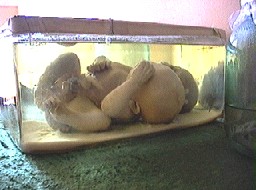The Shir Gazi Khan Madrassah (1726) is the oldest madrassah in Khiva and, in fact, is one of the earliest in Central Asia. Popularly known as the'Maskan-i-fazilan' ('residence of the enlightened'), the building was constructed by slaves who were promised their freedom by Shir Gazi Khan upon its completion. However, the years went by and the promises of freedom wore thinner and thinner until the slaves revolted and killed the Khan. Reputedly one of the greatest historians to write in Chaghatay literary Turkic, Shir Gazi's untimely demise prevented him from finishing his great work, 'Shajarai Turk' which was later completed by an anonymous source.
The madrassah itself was not finished until six years after the Khan-s death and was never given a frontal decorative facade. A rather stoic inscription above the entrance states, 'I accept death at the hand of slaves'. The madrassah went on to become an eminent place of learning with a widespread reputation and included students such as Mahatma Ghandi's grandfather.
Today the madrassah contains exhibits dedicated to poetry and medicine. Paintings of the poet Makhtum Kuli gather dust whilst the main attraction for jostling groups of schoolchildren is undoubtedly the pickled Siamese twins. Although most of the medicine exhibits have been dismantled the twins, born in Khorezm in the 1970's, remain a long standing favourite along with photos of similar twins and an unusally large gall stone. Look out for the woman's cloak in the right-hand-side gallery which is a fine example of the distinctive Karakalpak embroidery.
Like many of Khiva's monuments, the madrassah is suffering from the rising water table and the high salinity of the water. The first floor of the madrassah was buried in an accumulation of dust until excavated in 1957. Now some lower walls show evidence of salt and damp marks.

About this site
Khiva at a glance
First Impressions
Guidebook
Stories
Tour
Dichan Kala
Hidden Treasures
Highlights
Hotels and Restaurants
Other
Allah Kuli Khan Madrassah
Allah Kuli Khan Tim
Abdullah Khan Madrassah
Al Khorezmi Statue
Atajanbai and Mazar-i-Sharif Madrassahs
Ata Murad Matriza-i-Koshbegi Mosque
Bakcha Darvasa
Baghbanli Mosque
Carpet Shop
Dost Alimjon Madrassah
Execution Square
Garden
Hasan Murad Koshbegi Mosque
Korikhona
Kozi Kalon Madrassah
Khojash Mahram Madrassah
Muhammad Amin Inaq Madrassah
Matpana Baya Madrassah
Musa Tura Madrassah
Ota Darvasa
Okh Mosque
Photography Museum
Sayid Allaudin Mausoleum
Shir Gazi Khan Madrassah
Sayid Ota Mosque
Tosh Darvasa
Sights with a Story
Khiva at a glance
First Impressions
Guidebook
Stories
Tour
Dichan Kala
Hidden Treasures
Highlights
Hotels and Restaurants
Other
Allah Kuli Khan Madrassah
Allah Kuli Khan Tim
Abdullah Khan Madrassah
Al Khorezmi Statue
Atajanbai and Mazar-i-Sharif Madrassahs
Ata Murad Matriza-i-Koshbegi Mosque
Bakcha Darvasa
Baghbanli Mosque
Carpet Shop
Dost Alimjon Madrassah
Execution Square
Garden
Hasan Murad Koshbegi Mosque
Korikhona
Kozi Kalon Madrassah
Khojash Mahram Madrassah
Muhammad Amin Inaq Madrassah
Matpana Baya Madrassah
Musa Tura Madrassah
Ota Darvasa
Okh Mosque
Photography Museum
Sayid Allaudin Mausoleum
Shir Gazi Khan Madrassah
Sayid Ota Mosque
Tosh Darvasa
Sights with a Story







